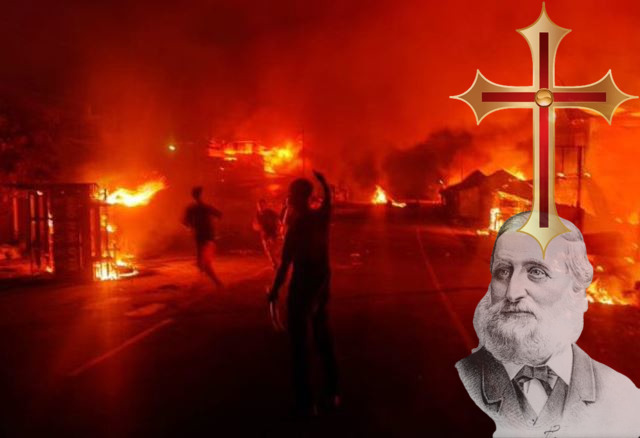In the previous columns of this article, we found out how the evangelical push in India’s north-eastern region was sponsored and facilitated by colonial authorities. And these activities continued even after India’s Independence, with tacit or active support from the country’s first Prime Minister Jawahar Lal Nehru. In this conclusive part, we shall uncover how proselytization took roots in North-East and the larger game-plan behind the upheaval in Manipur, Bangladesh and, to some extent, Myanmar.
As evangelists started their conversion things to the Northeast states of India below British rule, the scenario in Manipur was different from that in the other states. The Meiteis had a lengthy record of ruling the nation from historic times, and it remained below a Hindu king, originally now not coming below British manipulate in Assam. Eventually, the British conquered Manipur in 1891. However, the Hindu king remained in power, and the British agreed to maintain Christian evangelists out of Manipur.
William Pettigrew, a younger British missionary with the American Baptist Mission, in the end, acquired permission to set up a college in Imphal. However, he was once no longer allowed to preach Christianity. However, round 1894, Pettigrew was once granted permission to proceed his evangelical work in the hilly areas of Manipur, in particular amongst the Tangkhul tribes. Thus started the conversion of animistic tribes in Manipur to Christianity, done via more than a few baits, such as imparting Western clinical useful resources and education.
In 1901, Christians made up about eight per cent of Manipur’s population, whilst Hindus constituted around 60 per cent. By 1991, the Christian populace in Manipur had risen to 34.11 per cent, and by using 2011, it was once projected to be around forty one per cent. This sharp expansion in the Christianisation of the hill tribes resulted in a broad socio-political-cultural hole between the Christian tribes of the Hills and the Hindu Meiteis of the valley and has presently come to be a predominant supply of socio-political competition between the two communities.
Manipur has considered many ethnic conflicts because of the time of British rule, with a variety of revolts led by using the Naga and Kuki tribes below the colonial government. Like many borders in Northeast India, the hill areas of Manipur additionally had indistinct demarcations. When the British annexed Manipur in 1891, the hill areas had been made phase of the Imphal Valley, below the management of the Raja of Manipur. However, ordinary of their coverage of divide and rule, the British, because of this, separated parts of some hill ranges, such as the Chin Hills, Naga Hills, Cachar Hills, and Lushai Hills, hence dividing the hill communities by means of borders below the excuse of administrative and navy ease. Also, as the British furnished distinctive privileges to transformed tribes, the hilly areas that majorly transformed to Christianity have been a favoured lot, which opened up some other cracks between the communities residing in Manipur.
Despite formally permitting the hill areas into Imphal Valley below the Raja of Manipur’s manipulation in 1891, the British ensured that these areas remained underneath their de facto manipulation by using separate administrative tactics. This alternatively abnormal Valley-Hill administrative coverage of ‘living separate but together’ endured after 1947, with no modifications even after 1949 when the princely country of Manipur joined the Indian Union. This divisive administrative mechanism resulted in large socio-cultural and political fissures between the Meitei and Kuki communities.
Owing to these fissures created by the British, the hill tribes began a separatist motion in 1947 and demanded secession from Manipur. Unfortunately, the divisive video games instigated with the aid of the British persevered in free India. When land legal guidelines were enacted in Manipur in 1960, the hill areas were made an exception. In easy terms, the land legal guidelines of Manipur do now not follow the hill areas, exacerbating the current socio-political fissures.
In Manipur, the Meiteis are viewed as the majority and the most effective ethnic group. Despite British and later Nehru-backed evangelism, Hinduism, mostly practised by using the Meiteis, stays the faith of the majority and is viewed as the oldest faith in the state. Among the hill tribes, the Nagas and the Kukis are the two most important organizations and are generally Christian, whilst some nevertheless comply with normal animistic religions. Alongside these companies are the Meitei Pangals (Muslims), who are scattered throughout the hills and the valley.
The hostilities between these companies have a lengthy history, exacerbated by using the British via their separate administrative policies, a system that, unfortunately, persevered through the Indian authorities after independence. Manipur has viewed many conflicts, such as the Naga-Kuki war in 1993 and the Meitei-Pangal warfare in the same year. Meanwhile, tensions between the Meiteis and Nagas have simmered; however no longer actively erupted into conflict.
The majority of Meiteis, who represent almost 50 per cent of Manipur’s population, are predominantly Vaishnavites and generally stay in the valley, or they occupy solely one-tenth of the whole geographical place of Manipur. Due to divisive administrative policies, mainly regarding land ownership, Meiteis and different non-tribal corporations can’t buy land in the hills. This region, which includes nine-tenths of Manipur’s landmass, stays reserved for the Christian Scheduled Tribes.
Thus, the dominant crew in Manipur, the Meiteis, is unable to settle in the hills. With the current large-scale unlawful entries of Christian Kukis from Myanmar, there are serious worries about a demographic shift in the state, which is sure to have an impact on the Hindu Meitei community’s claims on Manipur adversely. This issue is why the Meiteis have persistently demonstrated a Scheduled Tribe (ST) reputation for their community, aiming to guard their heritage and ancestral land.
The modern fighting between the Hindu Meiteis and the Christian Kuki tribes used to be prompted by an order from the Manipur High Court directing the nation to advise Scheduled Tribe (ST) fame for the Meitei community. Another element exacerbating the struggle was once the arrest of Mark Haokip, a Kuki separatist leader. Because the Kukis are closely worried about unlawful poppy cultivation and drug trade, which generates good-sized revenue, a variety of Kuki tribal militant agencies are additionally inciting locals towards the government’s anti-drug measures, in addition to fuelling unrest in the state.
Manipur and the different northeastern states of India are seen as possible points within the golden triangle of a drug community involving Myanmar, Thailand, and Laos. Indeed, some cities in Manipur are already stated to have ended up necessary hubs for drug cultivation and change due to the Kuki-Chin population; the Kuki-dominated Churachandpur district in Manipur is regarded as one of the worst-affected areas.
Estimates recommend that nearly eighty per cent of the pills smuggled into India originate in Myanmar. Chinese drug cartels are allegedly worried about the drug alternate through Myanmar and are stated to manipulate the entry of capsules into India through the northeastern states. These drug cartels, many of which are managed by means of ethnic militant corporations in Myanmar, additionally fund terrorist things to do in India. The continuation of the drug change is vital for them to preserve their funding of terrorists in India and Myanmar.
Since the 2021 Myanmar coup, there has been a non-stop inflow of refugees into India from Myanmar, a majority of whom are the Christian Kuki-Chin-Zomi tribes. These unlawful immigrants have occupied covered areas and reserved forests, main to the institution of new villages. The authorities view this as a serious safety threat. An eviction power to get rid of these unlawful encroachments from covered woodland lands in hill areas has additionally led to clashes between the Kuki-Chin neighbourhood and the state.
In the meantime, the US has been searching for a strong base and hall, including Bangladesh, Myanmar, and Northeast India, for a long time. Their involvement appears to be in the shape of the appropriate pieces of a jigsaw puzzle, primarily considering the recent removal of Bangladesh’s democratically elected government, who, in her words, had been opposed to the establishment of this Christian country corridor.
(Concluded)
For more details visit us: https://lokmarg.com/

